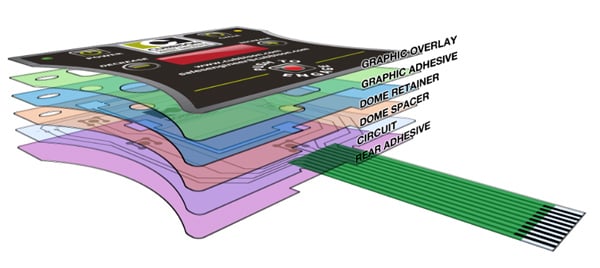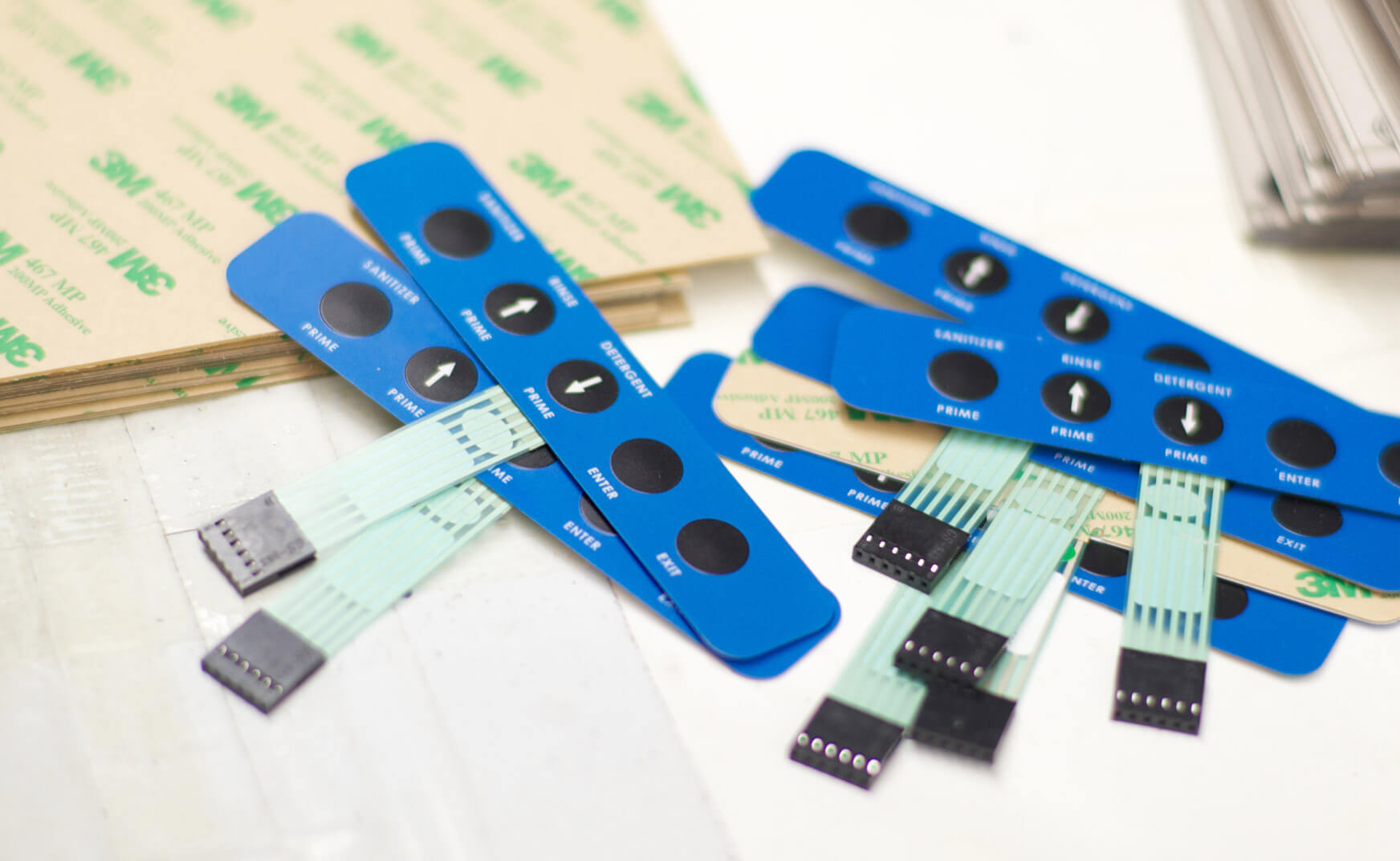The Importance of Membrane Switches in Creating User-Friendly Interfaces
The Importance of Membrane Switches in Creating User-Friendly Interfaces
Blog Article
Membrane Layer Switch Modern Technology: The Trick to Dependable and Cost-Effective User Interfaces
Membrane layer button technology has actually become a pivotal part in the layout of customer interfaces, offering both integrity and cost-effectiveness throughout a diverse variety of applications. Its durable building and construction makes sure resistance to environmental challenges, while the adaptability in layout enables tailored services that satisfy details market requirements. As we discover the complex benefits of membrane buttons, their capacity for development increases inquiries concerning future applications and advancing patterns. What does the next phase hold for this technology in a progressively digital landscape?
Recognizing Membrane Change Technology
Membrane layer button innovation is a widely used interface service in numerous electronic tools, supplying a seamless mix of capability and design. This modern technology incorporates multiple layers of products, usually containing a graphic overlay, spacer layer, and a circuit layer. The visuals overlay presents the interface aspects, while the spacer layer separates the circuit layer from the overlay till a customer turns on a button.
When pressure is applied to the overlay, the circuit layer completes the electric circuit, sending a signal to the device. This mechanism permits for different arrangements, consisting of responsive feedback and backlighting choices, improving customer interaction. Membrane layer switches are usually made using long lasting materials such as polyester or polycarbonate, making sure long life and resistance to ecological variables like moisture and dust.
The versatility of membrane layer switches enables their application in diverse industries, including medical gadgets, consumer electronics, and industrial controls. Their compact style enables assimilation into space-constrained atmospheres, giving an effective individual interface without jeopardizing aesthetic charm. Understanding the intricacies of membrane switch modern technology is essential for manufacturers and developers seeking to create reputable and effective human-machine interfaces.
Trick Advantages of Membrane Switches
While various user interface services exist, membrane switches offer distinct benefits that make them a favored choice in numerous applications. One of the key advantages is their toughness; membrane layer buttons are made to stand up to extreme environmental problems, including wetness, dirt, and temperature fluctuations, making sure durable efficiency. This durability significantly minimizes the requirement for frequent substitutes, therefore decreasing general maintenance prices.

Moreover, membrane layer switches are light-weight and small, making them appropriate for applications where room is limited. Their inconspicuous design adds to a sleek appearance without compromising performance.
Cost-effectiveness is additionally a notable benefit, as the production procedure for membrane switches over tends to be cheaper contrasted to traditional mechanical switches. This affordability, incorporated with their reliability and ease of setup, positions membrane switches as a sensible option for a large range of sectors looking for reliable and reliable interface.
Applications Throughout Different Industries
Exactly look here how do membrane switches adapt to the varied requirements of different markets? Membrane button modern technology is increasingly identified for its adaptability, making it suitable for a broad array of applications throughout multiple industries.
In customer electronics, membrane switches supply a compact remedy for remote controls and home devices, enhancing customer experience through intuitive layout. Additionally, the commercial field leverages membrane buttons for machinery control panels, gaining from their resistance to harsh settings, such as dampness and dust.
Armed forces and aerospace applications likewise utilize membrane buttons for their reliability and capacity to stand up to extreme conditions, guaranteeing operational performance in crucial circumstances. The food and beverage industry embraces these buttons for automated systems, where cleanliness and convenience of procedure are paramount (membrane switch). Inevitably, membrane switches are tailored to meet the special needs of each sector, verifying their vital duty in modern-day technology user interfaces
Design and Customization Options

In the world of membrane layer button innovation, style and modification choices play an essential function in improving capability and individual interaction. These switches can be tailored to satisfy particular operational demands and visual choices, making them flexible components in different applications.
One of the primary personalization options is the format of the button itself, which can be developed to suit special interface and ergonomic factors to consider. By changing the shape, dimension, and arrangement of buttons, producers can create instinctive designs that assist Your Domain Name in simplicity of use. In addition, the incorporation of various colors and visuals overlays enables branding and boosted exposure, guaranteeing that customers can rapidly recognize functions.
In addition, membrane layer buttons can be crafted with numerous responsive comments devices, such as elevated switches or audible clicks, to boost the customer experience. Different products can also be chosen for durability and ecological resistance, addressing aspects such as dampness, temperature variations, and chemical exposure.
Eventually, the comprehensive layout and personalization options available in membrane layer button innovation equip organizations to produce tailored solutions that not just fulfill useful needs but likewise line up with their branding and functional needs.

Future Fads in Membrane Layer Switches
As membrane switch innovation proceeds to evolve, future trends are significantly focused on improving customer experience and integrating innovative capabilities. One significant fad is the combination of touch-sensitive and capacitive modern technologies right into standard membrane switches. This advancement permits more intuitive interface, providing responsive comments while preserving a sleek style.
Another arising trend is making use of eco-friendly products, driven by the growing demand for sustainable production methods. Manufacturers are seeking to reduce their carbon impact by using recyclable substratums and low-impact inks, lining up with worldwide sustainability goals.
In addition, the surge of the Net of Points (IoT) is prompting the incorporation of smart features right into membrane buttons. Boosted connection membrane switch choices will enable devices to interact with each various other, enabling smooth assimilation into broader systems.
In addition, innovations in printing modern technologies, such as digital printing, are allowing for better design versatility and personalization. This enables manufacturers to generate intricate layouts and vivid shades cost-effectively.

Verdict
Finally, membrane layer button technology stands for a vital technology in individual interface design, using substantial advantages in durability, modification, and cost-effectiveness. Its prevalent applicability throughout diverse sectors highlights its value in modern innovation. As advancements proceed to arise, particularly in touch-sensitive user interfaces and lasting products, the possibility for membrane changes to boost customer experience and functionality stays promising. Proceeded exploration of this modern technology will likely yield additionally enhancements and expand its extent in future applications.
Report this page